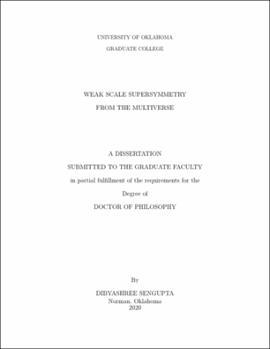| dc.description.abstract | The CERN Large Hadron Collider (LHC) has not found any experimental evidence yet for Supersymmetric (SUSY) particles. This has pushed the limits on the masses of SUSY particles in the multi-TeV region high enough to question whether nature is finetuned for SUSY to exists. However, with the introduction of the Electroweak (EW) fine tuning measure, some distinct SUSY models are found to be natural even if they involve highly massive SUSY particles. Naturalness require the superpotential mu parameter mu around 110 - 350 GeV. However, it is not straightforward to explain the origin of such low value of mu and this leads to the SUSY mu-problem. These natural SUSY models provide a higgsino-like Lightest Supersymmetric Particle (LSP) which can serves as a possible DM candidate (considering R-parity conservation) if it has no color or electric charge. Such a thermally-produced LSP alone cannot account for the entire DM content of the universe. At this point the Axion, arising in a different context, rescues the model from under-producing DM. The PQ solution to the strong CP problem, that gives rise to Axion, requires implementation of U(1)_{PQ} symmetry as the fundamental symmetry, which being a global symmetry, is incompatible with the inclusion of gravity. Hence the model suffers from a gravity-spoliation problem. Two hybrid models have been introduced here to simultaneously solve the SUSY mu problem, and the gravity-spoliation problem while still solving the strong CP problem. Since, the string landscape approach arising from multiverse argument could successfully predict the value of the Cosmological Constant, so the possibility that the magnitude of the Peccei-Quinn (PQ) scale is also set by string landscape considerations has been explored. It has also been shown how the string theory landscape affects the mirage mediated SUSY breaking framework and how it leads to a natural mixed decoupling/quasi-degeneracy solution to the SUSY flavor problem and a decoupling solution to the SUSY CP problem. A detailed phenomenological study of two important SUSY search channels in the LHC : 1. Gluino pair production and 2. Wino pair production for the natural SUSY models which has higgsino-like LSP have been done. Two other important channel for SUSY searches in LHC are top squark pair production and higgsino pair production. All of these search channels have been confronted with current LHC constraints and projected constraints from High Luminosity LHC (HL-LHC) and High Energy LHC (HE-LHC) to show what sort of upgradation is needed for LHC to discover or falsify natural supersymmetry. | en_US |
